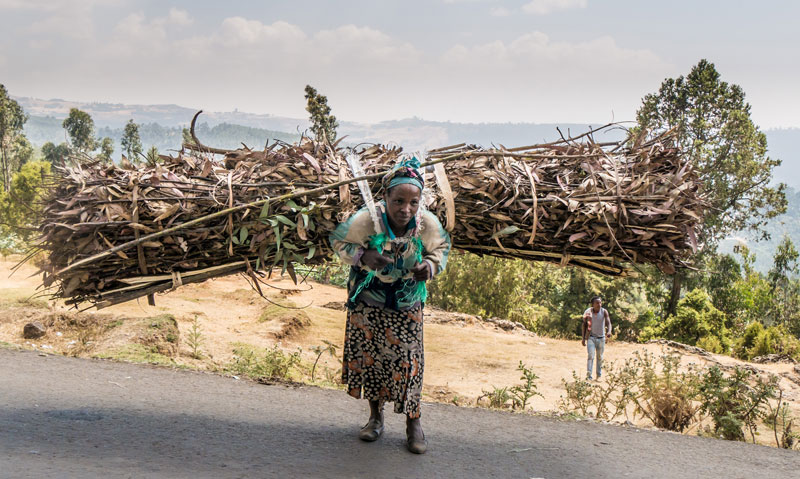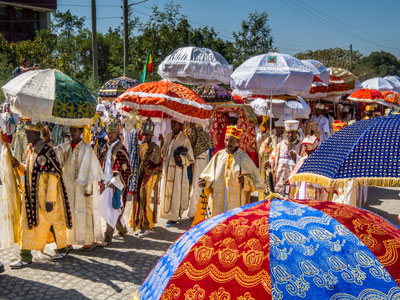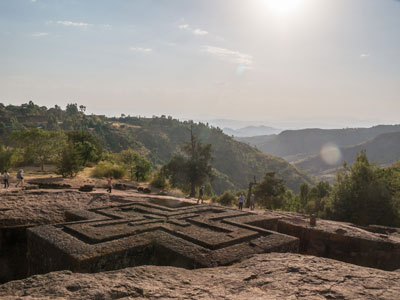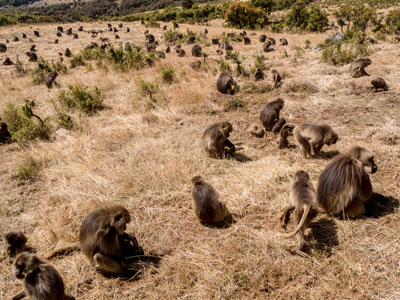One trip, two experiences – a group tour of Ethiopia vs. a private, customized journey
This article appears on page 6 of the July 2015 issue.
Ethiopia, historically known as Abyssinia, is an amazing country located in the Horn of Africa and well off the regular tourist track. In January 2015, my wife, Sandra, and I spent three weeks there, with the first 11 days as part of a 20-person photography tour with National Geographic Expeditions ($17,000 for the two of us). This tour concentrated primarily on the tribal areas in the south.
Following that, we spent nine days on a private custom tour ($6,000, total) arranged by Host Ethiopia Tour (Addis Ababa; phone +251 118 500304, hostethiopiatour.com). During this second period we were primarily in the north of the country, which has a long and interesting history.
The country
It’s certainly a travel-article cliché to say that a particular country is “a country of contrasts,” but, with apologies, I do have to say that about Ethiopia.
Bustling Addis Ababa hosts the headquarters of the African Union, the UN Economic Commission for Africa headquarters and more that 100 embassies. However, more than 80% of the country’s labor force, mainly subsistence farmers, live in rural areas. The contrast between life in Addis, the only large city, and the lives of the vast majority of citizens in the countryside could not be greater.
The Radisson Blu in Addis, where we stayed with our National Geographic group, was a 4-star “bubble” that made it easy to forget we were in Ethiopia, but outside of the capital, our “best available” accommodations ranged from tolerable to quite primitive. We quickly came to view the availability of hot water as a luxury.
The governing EPRDF political party dominates the northern part of the country; police presence was quite visible. But in the south, it was common to see tribesmen carrying AK-47 rifles. (We were told that these are largely status symbols but that they are occasionally used in intertribal disputes.) That said, we never felt we were in danger.
Poorly maintained dirt roads are ubiquitous, though 50 miles of modern 6-lane expressway leading east from Addis toward the important Red Sea port in Djibouti were recently opened. Toyota Land Cruisers are de rigueur for travelers. For the vast majority of Ethiopians, however, transportation means walking. In the south, making a 2-day walk to the nearest town market is not considered unusual.
It’s a mountainous country, with elevations ranging from 410 feet below sea level in the Danakil Depression to Ras Dashen mountain at 14,928 feet. Temperatures are correspondingly extreme; in January we experienced over 100°F in the southern Rift Valley and 50° in the Simien Mountains. Take longjohns and shorts! (Outside Addis, we did not stay in a single hotel that had heat or air-conditioning in the rooms.)
The tour
I don’t think it’s possible to do a better job on a group tour than National Geographic Expeditions (Washington, DC; 888/966-8687, www.nationalgeographicexpeditions.com) did on this one. Arrangements were thorough and precise, schedules were adhered to, and itinerary changes and improvements were made whenever the opportunity arose.
Our local minder and fixer, Henok Kebebe, our National Geographic (NG) tour coordinator, “JD” Kling, and our NG photographer, Chris Rainier (www.chrisrainier.com), were uniformly helpful, pleasant and always available.
For example, when we made stops where walking might be a challenge, JD routinely hired “helpers” for each of the several people in the group for whom walking was difficult. He clearly had been provided with enough discretionary cash to ease our way as necessary.
Our group of 20 consisted entirely of experienced travelers. This was very helpful; we had no one who was late for activities and no one who thought that the trip was only about them.
In anticipation of this “photographic” trip, I was curious to see if people with lots of big equipment and corresponding egos would dominate, but that was not the case at all. Probably a third to half of the group were serious photographers, but point-and-shoot was well represented.
We met for a “welcome dinner” in Addis on Jan. 10, then flew out the next day to Arba Minch, about 250 miles to the south (six hours by road). There we were met by the contingent of seven Land Cruisers that were to be our transportation for the next week.
During the week, we stayed at hotels in several towns: Arba Minch, Jinka, Turmi and Konso.
Village visits
The days were similar, with an hour or two of driving on very dusty, rough roads, then stops to take photos at villages and markets, finishing with another hour or two of driving to get back to the hotel. Usually there was a break of an hour or two midday, followed by a second activity in the afternoon.
The tribal villages and markets we visited were the real deal — no phony cultural shows, specially constructed tourist villages or anything else artificial. Tourism has touched the people, though, and charging for photographs is an important source of cash for them.
Typically, the NG folks would hire some tribespeople for a fixed fee, and we could spend an hour or so photographing them. Then we would move into the village and be mobbed with freelance “models” asking five birr (near 25¢) per person per photo.
Often people would jump in front of us as we walked or grab our arms, saying, “Photo! Photo! Five birr.” When you see how these people live, it is difficult to get upset with their pushing to get a few birr from tourists. Some of the big cameras we carried were probably equivalent in value to an entire village’s cash income for a year. Some of the travelers, though, were uncomfortable with the constant pressure and the touching.
The Mursi, Hamer, Kara, Daasanach and Konso were among the tribes we visited. Each tribe’s village was different, as were their outfits and jewelry.
In a couple of villages, the NG folks had arranged for traditional dances to be performed.
One day we had an NG-arranged audience with Gezahign, king of the Konso tribe, who has 300,000 subjects. It was a very interesting Q&A session. (He is a Western-educated civil engineer in addition to being a hereditary king and a religious leader.)
One afternoon we visited the Omo Child project, which works to eradicate traditional mingi infanticide practices among the tribes. (For more information, visit omochild.org/aboutmingi/mingi.) Learning about this horrific practice really brought home the extent of the cultural and physical isolation of the tribes in southern Ethiopia.
On to Lalibela
Following our time in the south, we flew to Lalibela in the north via Addis, with a one-night stopover at the Radisson there. Hot water for showers plus temperature-controlled and well-lit rooms — it was great!
That evening, the NG folks had arranged for us to get a lecture from one of Ethiopia’s top paleoanthropologists, Berhane Asfaw, who entertainingly led us through seven million years of hominid evolution in Ethiopia’s Rift Valley.
Lalibela is the home of Ethiopia’s most famous rock-hewn churches.
Simple to say but hard to do, the churches were created by cutting downward into the granite. First, the sides were outlined, then, as the cutting progressed, the upper windows were created.
Going in through the windows, the artisans carved out the ceiling of the church, then construction progressed downward, both inside and out, until an entire church was created.
As is visible in photos, the roof of the church is level with the ground. Amazing!
Our NG tour had been carefully scheduled to coincide with the 3-day religious festival of Timket, which celebrates Jesus’ baptism.
Hundreds of priests and deacons bring out each church’s replica of the Ark of the Covenant for celebrations that feature processions, drums, music and dancing. Within two to three hours of our arrival in Lalibela, we were in the center of the Timket celebration, photographing like mad!
From Lalibela, we all flew back to Addis and the rest of our group flew home, but the NG people had cheerfully helped Sandra and me make arrangements to fly to Gonder, where we met our guide, Oumer Seid, for our second, private tour. From that point, our schedule was our own, which was quite relaxing.
Tour two
In making tour arrangements the previous August, we narrowed our providers list down to two: Oumer from Host Ethiopia Tour and Eskinder Hailu of Ethiopian Tour. Both operators were exceptionally cooperative and contributed good ideas to our proposed itineraries.
Pricing was similar, and both were well recommended on the Internet and by the previous customers whom we contacted directly. The single difference was that Oumer was available to accompany us for the entire trip, while Eskinder’s arrangements involved our having different guides in each place. We enjoy developing a relationship with our guide, so Oumer won our business.
Gonder is the ancient capital of Ethiopia. Its main attraction is a royal palace complex containing palaces built by successive kings over 250 years.
Consistent with the somewhat isolated nature of the country, the architecture of the 16th-century castles is more reminiscent of first-millennium European buildings.
Gonder is also a major site for Timket celebrations, centered around ablutions in the holy water of the ceremonial Fasilides’ Bath complex, which we were also able to see.
From Gonder we drove to Simien Mountains National Park, stopping first to overnight in Debark before proceeding into the park.
For our visit, we were required to hire a guide and a “scout.” The scout was an elderly man carrying an equally elderly AK-47 rifle. Ostensibly, his job was to protect us from dangerous wildlife, but (less officially) we were told that it is simply a jobs program that allows the local economy to extract a little additional benefit from tourism. Both the guide and the scout were pleasant and helpful.
In addition to photographing beautiful scenery, we spent quite a bit of time taking pictures of the endemic gelada baboons. These animals travel in troops of maybe 100 and spend their dry-season time digging small pits in the ground to find moist grass roots to eat. They pay almost no attention to human visitors, which allowed us to wander with the troop and take as many pictures as we liked. It was easy to get within two or three feet of most individuals, mothers with infants being the exception.
The Simien Mountains are also popular with hikers. Multiday hikes can be arranged in Debark.
Our next stop was Axum, another ancient capital. Oumer’s original proposal was that we fly from Gonder to Axum, but we decided to drive because we’ve found that driving on trips gives us a chance to see a country and its people rather than just look at cloud tops. The 150-mile drive was an all-day affair over mostly rough, dirt roads, but we enjoyed seeing the countryside and the many villages we drove through.
Like most of the driving in the north, the terrain was mountainous and the roads had many switchbacks and high overlooks. None were dangerous, and the road width was adequate, but some ITN readers may not be comfortable making the choice to travel this route.
Axum’s two main claims to fame are (1) the Ark of the Covenant, said to be kept there, and (2) its steles, huge, solid-granite pillars used to mark the ancient Axumite tombs. The construction and transport technology used to create and move the steles is still somewhat of a mystery.
The largest of the steles, at 500 tons and more than 100 feet tall, now lies shattered on the ground. We were told that it was the victim of an earthquake.
Animal encounters
Sandra, Oumer and I flew from Axum back to Addis to meet the Land Cruiser and driver we would have for the balance of the trip. From the airport, we immediately headed south toward the Bale Mountains.
Ethiopia is not noted for its wildlife. Over thousands of years of farming, large predators like the Ethiopian black-maned lion have largely been eliminated. The Bale Mountains, however, are the habitat for two endangered Ethiopian species: the mountain nyala antelope and the Ethiopian red fox. We were fortunate to see both, the nyala in a government game reserve and the foxes in their natural mountain habitat.
From Bale we drove about four hours (150 miles) to Nazret, also known as Adama, for an overnight stop. The next day we drove about six hours to Harar, covering 260 miles all on good asphalt roads.
Harar is historically a Muslim town. Its economy is primarily based on the growing and selling of khat, a mild stimulant that is chewed widely in the Red Sea area, including in Somalia and Yemen. For tourists, the main attraction is the ancient walled city.
One highlight of our time in Harar was seeing the “hyena man.” Just after sunset, our driver took us to the dark outskirts of town to find him already feeding the wild hyenas that had come from the forest for their regular evening treat. We watched, the scene illuminated by our Land Cruiser’s headlights, as he fed these large and intimidating animals by hand. (An adult can weigh up to 140 pounds, and the crushing power of its jaws can exceed the jaw power of a brown bear.)
Had we wished, he would have let us feed the animals as well. We didn’t wish.
As I said, Ethiopia is not on the regular tourist track, so we were the only people there that night. The fee for our visit was 50 birr (near $2.50) each.
From Harar, we flew back to Addis and then home.
Food and lodging
If you’re headed to Ethiopia, I suggest researching the food before you go. Injera, which I’d very roughly describe as a huge gray sourdough pancake, is ubiquitous. It is made from a grain called teff and is used as both a serving plate and silverware.
One injera is laid on a serving platter, then various dishes are put onto it in little piles. This is the common plate for the group. Extra injera, rolled and served on the side, is provided. The meal is eaten by tearing off pieces of injera with the right hand and using them to pick up the food, which is then (along with the injera) popped into one’s mouth.
The most common dishes are wats, basically stews without a lot of liquid, and tibs, which are seasoned and fried strips of meat. Beef, chicken and lamb are the most common proteins.
The food was very good, and the eating was a lot of fun, but after a few meals we found the flavors to be somewhat monotonous.
Almost all of our meals were taken in hotels, since local restaurants pose a risk for Western digestive systems. As a result, there were always several Western meal choices.
The headliner was always spaghetti with tomato or tomato-and-meat sauce. Roast chicken was another common option. Without impolitely going into detail, I will just say that this was not a trip for foodies.
Ethiopian red wine was readily available and fairly drinkable, though not wonderful. The brands we saw were Rift Valley and the slightly less-expensive Acacia, both produced by the same winery. At the winery’s store, the Acacia was about $8 per bottle and the Rift Valley, a dollar or two more.
Food costs ranged from Western prices at the Radisson to what we found at one hotel restaurant, where the roast chicken cost 20 birr (near $1) and a bowl of creamy onion soup cost another 20 birr.
Most of our meals were included in the tour prices, but where they were not included, they were relatively inexpensive, maybe half what one would find in more developed countries.
As I said, we generally stayed in the best-available lodging wherever we were. The range covered by “best” was wide. The Radisson Blu was, of course, at the top, but in several places we rejoiced just to get a dribble of warm water for a shower.
Electricity was spotty at times, and in one hotel we woke up with many little red marks that we eventually concluded must have been flea bites.
That said, here are some of the nicer properties we stayed in and can recommend: Radisson Blu, Addis Ababa (www.radissonblu.com); Kanta Lodge, Konso; Mountain View Hotel, Lalibela (http://mountainview-hotel.com), and Sabana Beach Resort, Lake Langano (www.sabanalangano.com).
Insights gained
Ethiopia is not a country where self-drive travel works. Roads are virtually never marked, and I couldn’t even find a good GPS map file for the country. The signs that do exist are in Amharic.
Would we recommend the National Geographic Expeditions tour? That is a difficult question, and the answer depends very much on what kind of experience you’re looking for. As I said, it was superbly designed and managed. We have nothing but praise in that regard. But with the NG tour costing well over double the per-day cost of a completely customized private tour, our conclusion was that it was not a good value, comparatively.
We prefer the flexibility of traveling alone with a private guide and driver, but others may prefer a group experience and not be concerned about the cost.
It is a worthwhile trip if you like being off the beaten tourist path and don’t expect the level of lodging and amenities you’d find in more developed areas of the world.
Tourism is currently only 5% of Ethiopia’s GDP, but it is growing fast. The country is developing fast as well, having significant foreign aid and direct investment.
What this means is that if you want to see what we did, a place and people relatively untouched by the 21st century, you should go soon.





